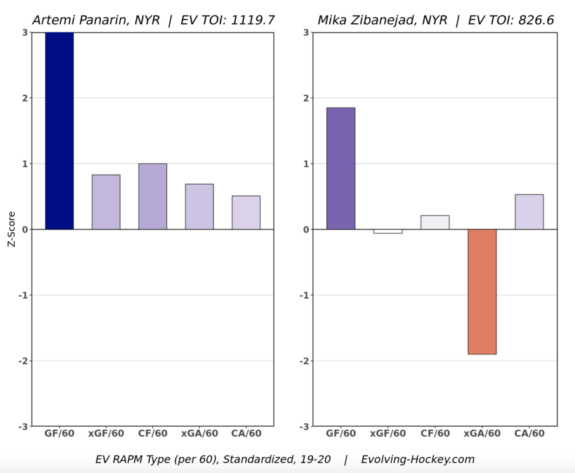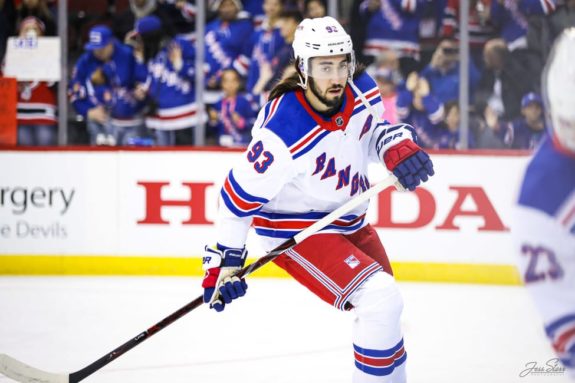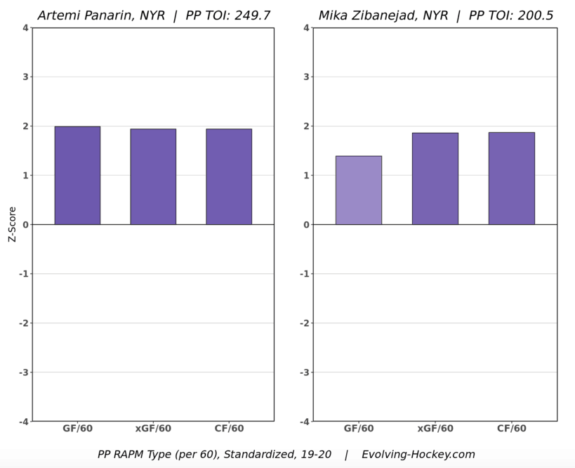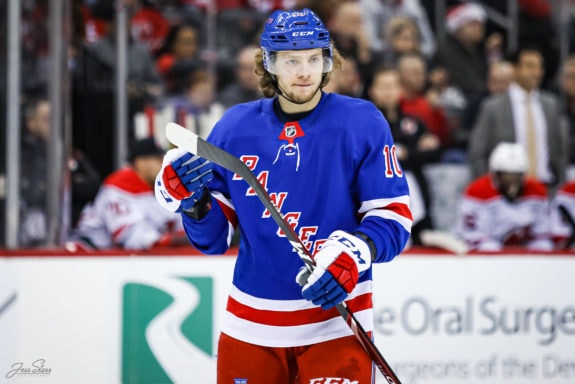Assuming that the New York Rangers’ regular season has concluded in light of the COVID-19 pandemic, there’s a much-needed discussion to be made in the form of the team’s most valuable player. At one point in time, it appeared that Artemi Panarin was the lone competitor for such an honor, but as the calendars turned to 2020, Mika Zibanejad suddenly burst into the MVP conversation with his unstoppable scoring touch.

Considering the whole hockey world is twiddling their thumbs in anticipation for the fate of the 2019-20 season, there doesn’t seem to be a better time to invoke discussion and debate between two of the best Rangers performers since the turn of the century. We’ll consider three categories when comparing the two players — offensive contribution, responsibility on defense, and special teams impact. Going by those three metrics, we should be able to decipher whom the Rangers’ most valuable player was for the 2019-20 season (thus far).
Offensive Contribution
Both Zibanejad and Panarin are far and away the top offensive contributors on the Rangers. The duo accounts for 27% of all points from the entire team. Ryan Strome is the next highest scorer on the team with 59 points, but many of those were due to Panarin and his scoring/playmaking ability. What’s even more impressive about their incredible scoring pace is that neither Panarin or Zibanejad saw extended time together in five-vs-five (5v5) situations. Their contributions to the Rangers’ offense were almost entirely individual efforts, which should speak volumes on how integral they’ve become to the roster. The real discussion lies in how they compare against each other.

Despite playing in 12 fewer games and almost 200 fewer minutes than Panarin, the 26-year-old Swede managed to eclipse the 75-point mark and close the gap on the MVP conversation. His 1.32 points-per-game (P/G) were fairly close to Panarin’s 1.38 P/G rate. However, Panarin still owns a hefty edge in overall point production. He owns a 3.28 points-per-60-minutes (P/60) at 5v5 while Zibanejad produced at 2.78 P/60. The two ranked second and 11th in the NHL respectively in P/60 amongst skaters with 700 or more 5v5 time-on-ice (TOI).
Related: One for the Ages – Sergei Zubov’s 1993-94 Season
The 28-year-old Russian also topped the NHL with 59 points at 5v5 strength, many of which came thanks to his natural playmaking ability. Panarin led the NHL in primary assists at even strength and his 1.22 primary assists-per-60-minutes at 5v5 was good for seventh in the league. In comparison, Zibanejad wasn’t even second amongst Rangers in either metric, much less the entire NHL.

Where Zibanejad really begins to close the gap on Panarin is in their goal scoring rates. Both enjoyed career highs in goals this season, but Zibanejad was amongst the top scorers in the NHL. His 41 goals ranked him fifth in the league, trailing only David Pastrnak, Alexander Ovechkin, Auston Matthews and Leon Draisaitl — pristine company, to say the least. His 1.42 goals-per-60-minutes at 5v5 ranks him 7th in the NHL, however, his nearly 20% shooting percentage ranks among the highest in the league as well.
It’s fairly clear that Zibanejad, while a goal-scoring machine, is still producing at an unsustainable rate. He won’t be scoring five-goals a game on a regular basis. On top of the high shooting percentage, he also lacks in 5v5 goals and actually trails Panarin in that regard. If anything, Zibanejad was scoring at an inflated rate, while Panarin was due for more goals.

Despite Zibanejad’s insane 0.72 goals-per-game pace, it’s still fairly clear that Panarin holds a commanding lead in offensive contribution. He drives the puck movement and possession any time he’s on the ice, consistently creating chances even when he’s not the focal point of a play.
Responsibility on Defense
Neither player is particularly known for their two-way play. As a center, Zibanejad holds a considerably larger defensive responsibility He’s a far more complete player when considering physicality and board play. He doubled Panarin’s totals in both hits and blocked shots.
Related: Rangers’ Top Candidates for Next Captain
It’s rare to see Panarin throw his 5-foot-11, 169-pound frame around all that much. He’s far more reliant on his active stick play and quick hands when challenging in the neutral zone or providing the second pass on a breakout.

As confident as Panarin is with the puck, he does own an average of 3.5 giveaways-per-60-minutes at 5v5 strength. That could be an effect of him being the focal point of the offense, but the responsibility still lies on his shoulders to not commit a neutral or defensive zone turnover. That being said, he’s quick to recover from any giveaways as he led the team with an average of 2.56 takeaways-per-60 minutes at 5v5 strength. He also holds a slight lead over Zibanejad in Corsi-percentage, but that’s more in part to his shot generation than his individual shot suppression.
Zibanejad’s defensive ability shines in shot suppression and remaining in possession. He held a respectable 49.53 Corsi% at 5v5 strength and led the team in individual Corsi-for per 60 minutes even when his line was the most likely to start in the defensive zone. He also led all Rangers’ centers in Corsi-against per-60 minutes, despite matching up with the opposing top-line on most nights. It’s worth mentioning that both Chris Kreider and Pavel Buchnevich own considerably lower possession metrics when playing without Zibanejad.
Special Teams Impact
Often times Zibanejad and Panarin were simply feeding each other on the man-advantage so many of their numbers are similar. That being said, there was still a slight gap between the two and their success on the power play.
Related: Rangers Future Resides with Mika Zibanejad
The Rangers own a 22.9% power-play percentage, seventh in the NHL and fourth in the Eastern Conference. Much of that success can be attributed to Panarin and Zibanejad’s chemistry. In fact, 12 of the duo’s 22 power-play goals were assisted by each other.

Zibanejad owns the edge with 15 power-play goals to Panarin’s seven and also has three more points while playing in almost 50 fewer minutes on the power play. However, Panarin leads in all three of goals-for per 60 minutes, expected goals-for per 60 and Corsi-for per 60 minutes. It’s fairly evident that Panarin generates more offense, but fails to score nearly as much as Zibanejad.
Panarin scored on just 13% of his 53 shots on the power-play, whereas Zibanejad, Kreider, Buchnevich and even Jacob Trouba owned a higher shooting percentage. He was generating plenty of chances as both a playmaker and scorer on the man advantage, while Zibanejad was a bit more reliant on just scoring.
Zibanejad is also featured on the penalty kill where Panarin rarely sees time. Unfortunately, the Rangers penalty kill pales in comparison to their power play. They own a 77.4% success rate on the PK, good for 23rd in the NHL.

All things considered, Panarin’s edge in his offensive contribution and impact on the man-advantage makes him the clear choice for the Rangers’ most valuable player. Zibanejad, while more defensively sound and has a more 200-foot type of game, will have to settle for second to Panarin’s prowess. It’s not often that the Rangers have a player who was on pace for a 113-point season. After all, he leads the NHL in goals-above-replacement and in wins-above-replacement. It’d be a disappointment if such a dominant season wasn’t recognized as one of the greatest by a Ranger.
One can only hope that we can go back to watching these two superstars sooner rather than later. As it stands, the Rangers’ newest free agent superstar has completed his first (albeit shortened) season as the clear cut team’s MVP.
Stats courtesy of Evolving Hockey, NaturalStatTrick and Hockey Reference.